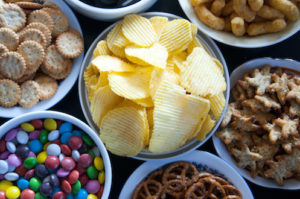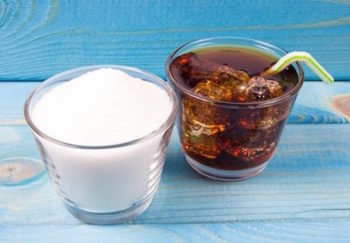
Some of us reach for the candy jar to satisfy those mid-afternoon cravings. Others go straight for the chips. When it comes to heart health, who is better off: the sugar lover or the salt fanatic? According to registered dietitian Katherine Basbaum, it’s not so much which white stuff you’re eating but how you’re eating it.
Sugar
USDA dietary guidelines have been fairly vague in the past when it comes to just how much added sugar — sugar not occurring naturally in foods like fruits and dairy products — we should be consuming. “Now the USDA recommends that less than 10 percent of our total calories consumed come from added sugars,” says Basbaum.
The shift comes, in part, as a result of previously suppressed research findings linking sugar intake to heart disease. (In case you missed it, there were some pretty damaging reports about the sugar industry in the news recently. According to an article in Forbes Magazine, more than 50 years ago, the Sugar Association helped to diminish sugar’s role in heart disease, pointing instead to dietary cholesterol and saturated fat.)
What we now know is that consuming excess sugar leads to weight gain, insulin resistance and type 2 diabetes, all of which directly impact your heart health. “More and more research is now pointing to sugar as a major culprit for the heart disease increase in the U.S.,” says Basbaum. When you look at just how much added sugar we’re consuming, that makes perfect sense.
To break it down, the American Heart Association now recommends that we consume no more than six teaspoons of added sugar per day. Yet, according to findings by the Harvard School of Public Health, more than 70 percent of Americans eat at least 22 teaspoons per day of added sugar. That’s more than three times the recommended amount!
So how are all of you sugar lovers supposed to cut back? Basbaum has some tips:
- Limit sodas, juices, sweetened teas/coffees and sports drinks, the most common source of added sugars
- Read the label: if sugar is listed among the first five ingredients, you know there’s a high amount in that item
- Be aware of sugar pseudonyms, such as corn syrup, honey, dextrose and others
- Just because it doesn’t taste sweet doesn’t mean it doesn’t have sugar
- Satisfy a sweet tooth with fresh fruit
- Make your own treats using low-sugar recipes
- Spend your sugar calories wisely — indulge in a small glass of real soda or a piece of chocolate, then limit yourself the rest of the day
Salt
Don’t reach for the chip bag just yet! Like sugar, too much salt in your diet can also take a toll on your heart. “There is solid research pointing to elevated levels of dietary sodium increasing blood pressure, which puts you at a higher risk for heart disease and stroke,” says Basbaum.
In its recent dietary guidelines, the USDA recommends that everyone limit sodium intake to 2,300 mg. That’s approximately a teaspoon of salt, which seems like more than enough to satisfy. The problem is, most of us are eating much more than that — not because we’re reaching for the saltshaker, but because we’re eating out or eating too many processed foods. “Seventy-five percent of the sodium Americans consume comes from processed or packaged and restaurant foods,” says Basbaum.
So if you crave salty snacks, Basbaum has some tips to be sure you’re not getting more sodium than you bargained for:
- Remember that even foods that don’t taste salty can still be high in sodium
- Avoid canned foods if possible; rinse items like canned beans and vegetables in cold water prior to cooking to remove 30-40% of excess sodium
- Go for fresh or frozen (frozen vegetables – without sauces – don’t have the preserving juices or seasonings that can up the sodium levels)
- Use garlic, herbs or vinegar to add flavor
- Limit packaged foods
- Cook whole foods at home using low-sodium recipes
- Use salt, but use it very sparingly
“Even if you have heart disease, you don’t have to hide the salt shaker so long as it is just a shake or two,” says Basbaum. “If the highest proportion of your daily meals come from fresh, whole foods that were home-cooked using minimal added salt, you should have no trouble sticking to the recommended teaspoon of salt. Just spread it out over the course of the day.”

